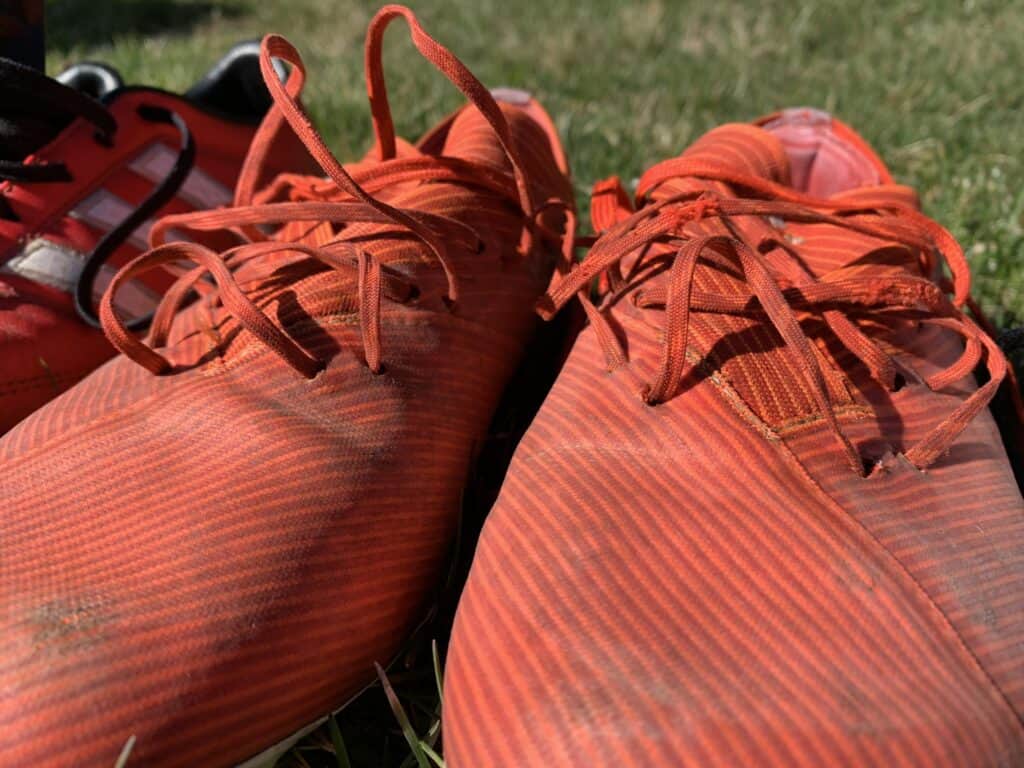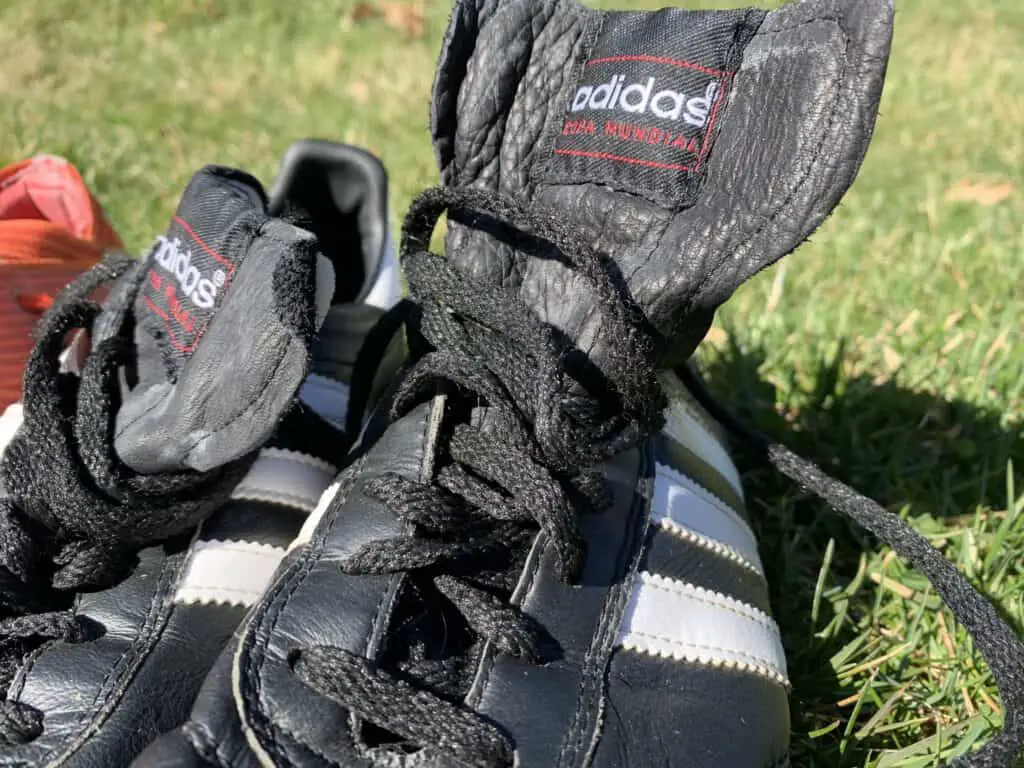It’s common for players to wonder how long soccer cleats or other soccer equipment last. Each pair is different and, depending on how they’re used, lasts a different amount of time. When the shoe starts to rip, or the spikes start to dull, it might be time to buy new ones.
On average, soccer cleats last 4 to 10 months. Signs that you should buy new cleats include the shoe tearing away from the sole, shortened or missing spikes, and ripped eyelets. Manufacturers typically offer refunds for cleats that tear within a specified timeframe—leather cleats generally last longer than synthetic ones.
Read on to learn more about how long soccer cleats last and how to make them last longer.
Related: Synthetic vs. Leather Soccer Cleats – A Complete Guide
Table of Contents
How long do soccer cleats last?
How long your soccer cleats last depends on many variables, like how frequently they’re used. For example, if you only play soccer a few times a year, then there’s a chance your cleats could last a lifetime. However, your cleats could last only a season if you play year-round. How long do cleats last in general?
Soccer cleats are designed to last one 3 to 4-month season. If you play soccer competitively more than three times a week, your cleats are more likely to rip and need replacing earlier than someone who plays less. If you only play soccer casually once a month, your cleats can last multiple years.
Additionally, if you play on a surface not meant for your cleats, they can last less time. Artificial grass (AG) cleats are meant for turf, not natural grass. Using AG cleats on real grass makes you more likely to slip while running or planting, increasing your shoes’ wear.
Related: Does Water Ruin Soccer Cleats? (Keep them Dry!)
Conversely, firm ground (FG) cleats are not designed for artificial grass or turf use. The studs on these cleats can wear down over time if used on turf. If your studs are too short, they won’t work on firm ground, and you will need to buy a new pair.
Do leather cleats last longer than synthetic ones?
The age-old question of which soccer material lasts the longest: leather or synthetic? The answer is pretty straightforward.
Leather cleats tend to last longer than synthetic ones because the material is more durable and flexible. Leather cleats can last up to 2 years with proper care, whereas synthetic cleats will almost always have shown significant signs of wear and tear by then.
For leather cleats, I recommend you consider going a half size down. Leather cleats can stretch to fit the shape of your foot and, if they stretch too much, could become loose over time.
Just because leather cleats last longer does not mean that they’re better than synthetic ones. Each soccer cleat material has its pros and cons.
Leather cleat pros
- Durability
- Form-fitting
- Flexible
- Softer, more padded touch on the ball
Leather cleat cons
- They can become too loose if they stretch too much
- Harder to feel the contact of the ball on your foot
- They can tear more quickly if they expand too much
| Pros | Cons |
|---|---|
| Durability | They can become too loose if they stretch too much |
| Form-fitting | Harder to feel the contact of the ball on your foot |
| Flexibility | They can tear more quickly if they expand too much |
| Softer, more padded touch on the ball |

Synthetic cleat pros
- Much lighter than leather
- Closer feel to the ball
- Stay true to size
- Less cushion when striking the ball
Synthetic cleat cons
- Won’t stretch if you need them too
- Tear more quickly and abruptly
- Take more time to break in
| Pros | Cons |
|---|---|
| Much lighter than leather | Won’t stretch if you need them too |
| Closer feel to the ball | Tear more quickly and abruptly |
| Stay true to size | Take more time to break in |
| Less cushion when striking the ball |
What soccer cleats last the longest?
The challenge of buying new soccer cleats is finding a balance between durability, functionality, and, sometimes, fashion. Finding a pair of soccer boots that work well and look stylish is most important for some. For others, it’s all about getting the most prolonged use out of their cleats. Which ones last the longest?
On average, leather soccer cleats last the longest. Leather is more durable and flexible than synthetic materials. Some synthetic cleats last longer than some leather ones, but it depends on how often you use them and if you take proper care of them. Leather cleats can last anywhere from 4 months to 2 years.
Leather options are generally the most durable soccer cleats. There are many variables factored into the longevity of soccer cleats. Finding the right size is one of the most important things. Adidas Copa Mundials are a famous high-quality, long-lasting leather boot.
You may even find that your weak foot cleats last longer than your dominant foot. This happens because you kick the ball more with your dominant foot. I’m right-footed, and my right shoe is much more damaged than my left.

Be sure only to use your cleats on the correct surface; AG cleats on turf and artificial grass and FG cleats on regular, firm grass fields.
When should you buy new soccer cleats?
There comes a time when you need to pick up a new pair of boots. When is it time to buy new soccer cleats?
There are many reasons one might need new soccer cleats. They may have ripped, become too small, or the studs may have worn out. These signs of wear and tear are expected after a few months of using them 3-5 times a week. It’s time to buy new ones if one or two of these things have happened to your cleats.
If you’re not in the market for a new pair of cleats after ripping yours, try gluing them together. You might be forced to buy new soccer cleats if the glue doesn’t do its job. If you attempted glue and it didn’t work, now might be the best time to buy soccer cleats.
You don’t need to buy new shoes if the laces rip. Soccer stores and online retailers sell soccer shoelaces for all types of cleats. If the laces tear on your cleats, it’s not the end of the world; just buy new ones. The same goes for the insole of the shoe.
In the event that you or your child has outgrown soccer cleats, it’s time to buy new ones. Cleats that are too small are uncomfortable and have a higher chance of ripping.
If you’re wondering what to do with old soccer cleats, you can either dispose of them or save them as an emergency backup.
6 ways to make your soccer cleats last longer
Maintaining your soccer cleats is integral to getting the most out of them. With proper care, you can make them last even longer. In addition to soccer cleat upkeep, there are a few proactive measures you can take to make sure they last as long as possible.
Make your cleats last longer by finding a cleat that fits your foot. Narrow feet should use narrow cleats, and wide feet should use wide cleats. Pick a size with minimal space in the heel and toe that isn’t uncomfortably small. Only use the cleats on their intended surface, avoid wearing them on pavement or hard surfaces, and clean them regularly.
If you do all of these things together, your cleats are guaranteed to last longer, barring any factory defects.
If your cleats rip earlier than anticipated, check the manufacturer’s website for their return policy or email their support team to see if you qualify for a refund. Many brands, like Nike and Adidas, provide a warranty for faulty soccer cleats.
Find a soccer cleat that fits your foot shape
First things first, find a cleat that fits the shape of your foot.
Narrow cleats work better for people with narrow feet, and wide cleats work better for people with wide feet. Someone with narrow feet using a wide shoe could experience slippage inside the show. A person with wide feet in a narrow shoe could become uncomfortable during play and even rip through the shoe.
Nike cleats are known for being more narrow than Adidas cleats. I recommend looking into Adidas and Diadora cleats if you have wide feet or Nike if you have narrow feet.
Find the right size
The correct shoe size for a soccer cleat fits your foot firmly with minimal extra space. Find a cleat that’s the same or similar size as your other shoes. Pick a size with as little extra room as possible but not one where your toes rub against the front.
There’s a greater chance your foot will rip through the shoe if there’s too much room. There’s also a chance for them to rip if you buy too small of a size.
Use the correct type of cleat for your playing surface
The type of cleat you use matters tremendously for functionality and safety.
Artificial grass cleats have a much different spike length and pattern than firm ground cleats. Only use cleats as they’re intended. The standard soccer cleat is a firm ground cleat used on firm, usually grass fields.
Note: If your team practices on turf but plays on grass (or vice versa), I recommend using only FG cleats or buying two pairs of cleats; FG and AG.

Avoid wearing them on asphalt or hard surfaces
Another way to ensure your cleats last longer is to wear them only when you’re on the field.
Asphalt, cement, and other hard, non-soccer field surfaces can wear down the studs on your soccer cleats and even crack the sole, making the shoes last significantly less time. Avoid added damage to your cleats by only wearing them during training or games.
Tip: Wear running shoes, slides, or sandals to and from soccer practice or games so you don’t have to wear your cleats off the field.
Clean them properly
Dirt and mud can be harmful to your cleats over time. Clean them once in a while to make them last longer.
Use cold water to clean the outside of your soccer shoes. Too hot of water can damage and weaken the material. Use a soft bristle brush to gently remove dirt and scratches from the shoe’s upper material. Avoid using harsh cleaning chemicals to clean your soccer shoes, as they can damage them.
Keep them dry
Although you can play soccer in the rain, you must keep your cleats dry when not using them.
Water can damage the cleats over time. To dry them off, use a towel on the outside material and stuff the inside with newspaper or paper towels. This prevents additional and harmful decay of the upper material and the inside of the shoe.
Related: How to Dry Soccer Cleats Fast in 6 Steps
How long do Nike soccer cleats last?
Nike soccer cleats will last at least one season. If they rip or you discover a flaw within 60 days of the purchase, you can return the cleats to Nike for a full refund.
Do expensive soccer cleats last longer?
Any soccer cleats will last longer if you care for them properly. Expensive cleats will last longer if they fit your foot shape, are the right size, and wear them on the correct playing surface.
